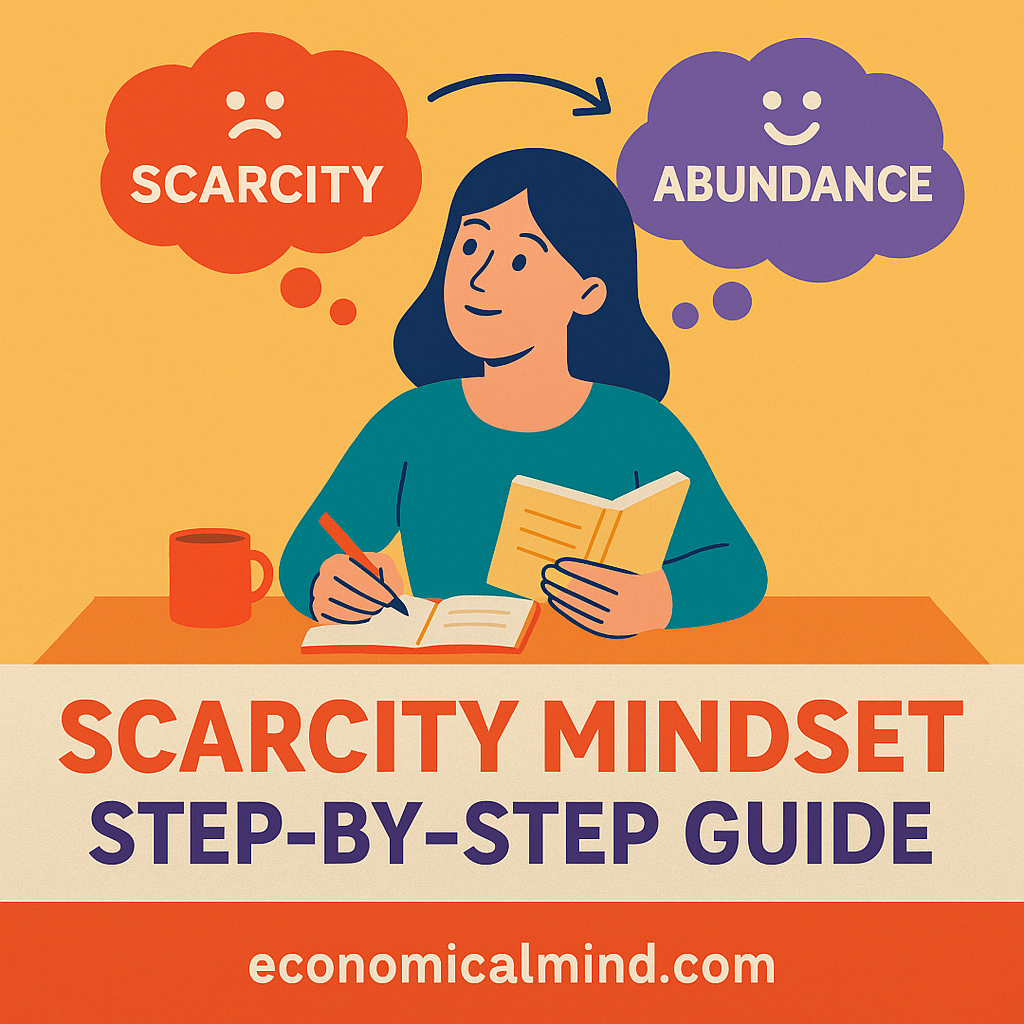
What Is a Scarcity Mindset?
A scarcity mindset is the belief that there’s never enough — money, time, or opportunity. It makes you focus on what you lack instead of what you can create.
When you think in terms of scarcity, decisions often come from fear — like saving too cautiously, avoiding risks, or feeling guilty about spending. Over time, this mindset can limit growth, creativity, and financial confidence.
The good news? With awareness and consistent practice, you can replace scarcity with an abundance mindset — one that helps you thrive financially and emotionally.
Step 1: Identify Scarcity Thinking
The first step is to notice when scarcity thoughts appear.
Common examples include:
- “I’ll never have enough money.”
- “There aren’t enough opportunities for me.”
- “If they succeed, I lose.”
- “I can’t afford to invest in myself.”
Write down your recurring money fears or limiting beliefs. Awareness turns vague anxiety into something you can actually challenge and change.
Step 2: Challenge Negative Beliefs
Scarcity thoughts are often inherited — from family, culture, or past experiences.
To break the pattern, ask yourself:
- Is this belief true, or is it a fear from the past?
- What evidence do I have that supports the opposite?
- How would I act if I believed abundance was possible?
Replacing automatic “I can’t” statements with “I’m learning how to” slowly reprograms your mindset toward possibility.
Step 3: Practice Gratitude Daily
Gratitude is the simplest way to shift focus from lack to abundance.
Every day, write down three things you’re grateful for, especially around money or resources.
Examples:
- “I’m grateful for steady income.”
- “I’m thankful for the chance to learn about money.”
- “I appreciate having supportive people around me.”
This practice retrains your brain to notice what’s already working — which naturally attracts more positive financial energy.
Step 4: Reframe How You See Money
Instead of viewing money as something scarce or stressful, start seeing it as a tool for creating options.
Money is neutral — it’s neither good nor bad. It simply amplifies your choices.
When you believe there’s always more to earn, create, or share, financial opportunities start to expand.
Pro tip: Focus on what money can do for you (security, freedom, giving) rather than what it represents (status or fear).
Step 5: Surround Yourself With Abundance Thinkers
Your environment shapes your beliefs.
If you spend time with people who constantly complain about money or scarcity, it reinforces that mindset.
Instead:
- Follow creators who teach financial literacy and positive habits.
- Read books like The Psychology of Money or You Are a Badass at Making Money.
- Join communities that celebrate progress, not just wealth.
Being around abundance thinkers helps you internalize that growth is possible — for everyone.
Step 6: Set Growth-Oriented Financial Goals
Scarcity focuses on survival; abundance focuses on growth.
Set goals that stretch you but feel achievable:
- “I’ll save $100 this month.”
- “I’ll earn an extra $500 from a side project.”
- “I’ll invest 10% of my income for my future.”
As you hit each milestone, your confidence grows — and scarcity fears lose their power.
Step 7: Give, Even When It’s Small
It may seem counterintuitive, but giving helps break scarcity thinking.
Donating money, time, or energy proves to yourself that there’s enough to share.
You don’t need to give much — even $5 to a cause you care about or a small act of generosity can reinforce abundance.
When you give freely, you signal trust that there will always be more.
Bonus Tip: Visualize Abundance
Take five minutes daily to visualize your ideal financial life.
Picture what stability, comfort, or generosity would look like — and feel it as if it’s already real.
This practice helps your brain accept new possibilities and align your behavior with that belief.
Final Thoughts
The scarcity mindset keeps you trapped in fear and limitation, but it’s not permanent.
By becoming aware of your thoughts, practicing gratitude, and taking small steps toward growth, you can shift into abundance — where opportunities, money, and confidence flow naturally.
Remember: abundance isn’t about having everything — it’s about trusting there will always be enough.
